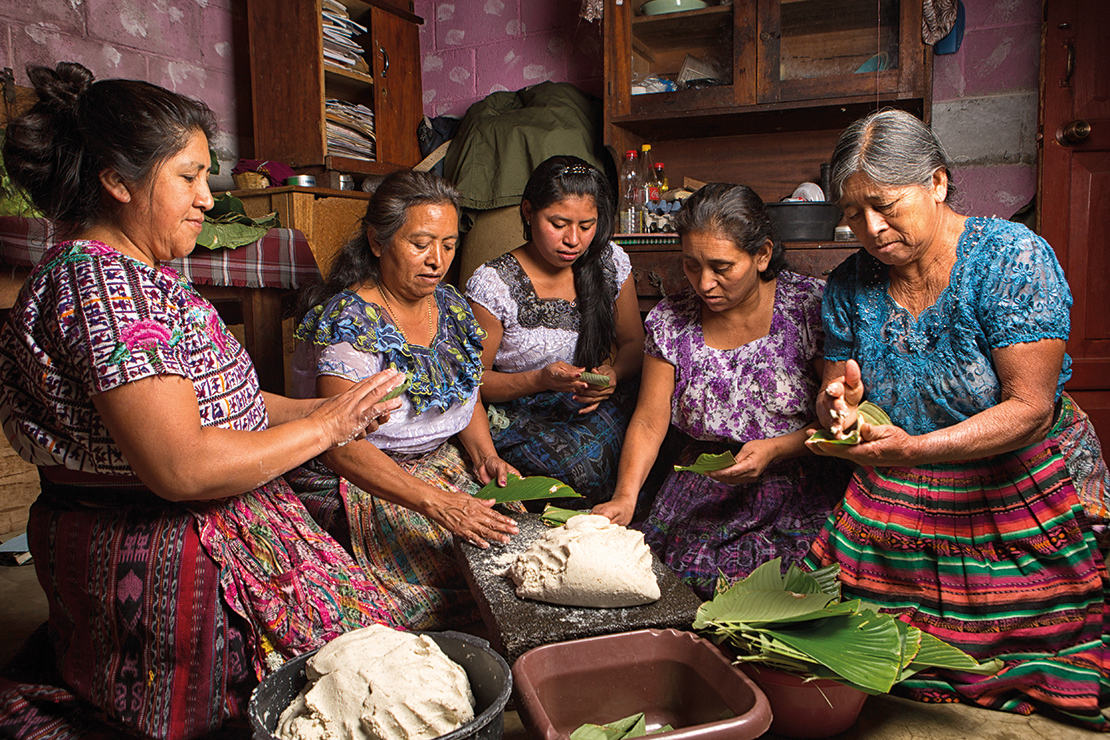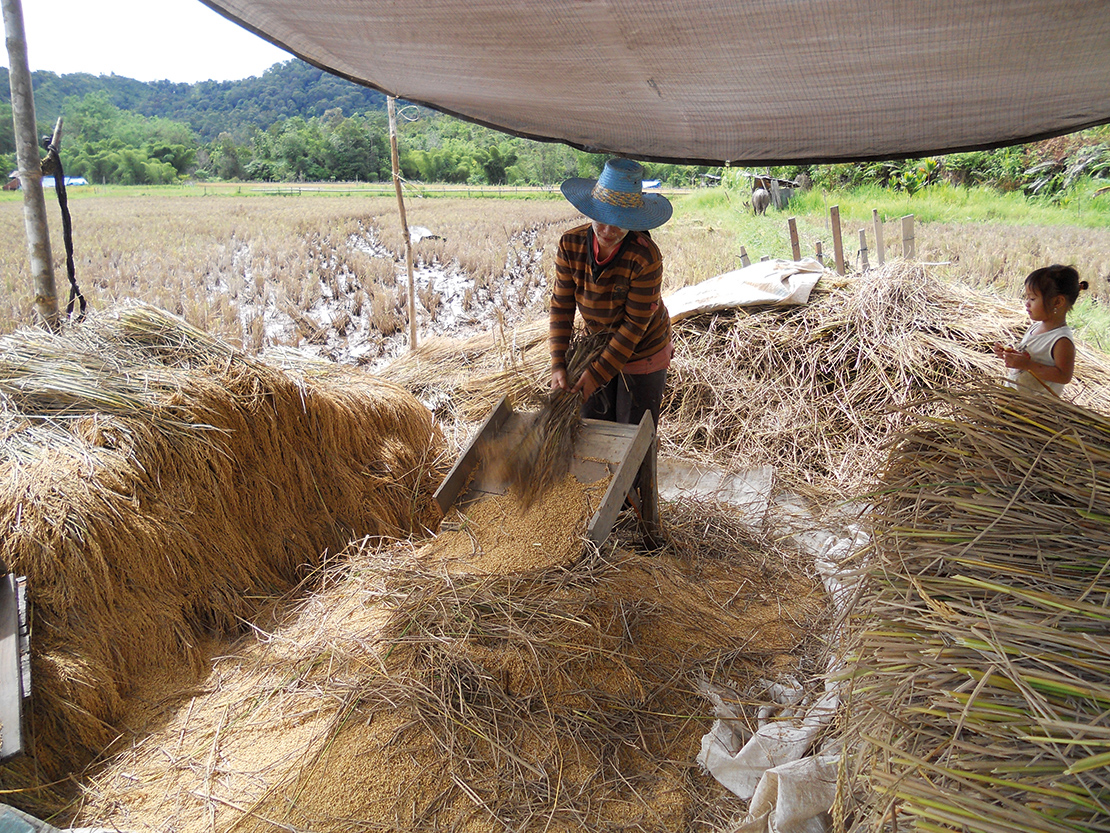Food transition: Revitalising indigenous and local food systems
Vision
Vibrant ecosystems and cultures ensure genetic diversity and diverse diets, improving health, resilience and livelihoods. Revitalised indigenous and local food systems contribute to local food security, food sovereignty and agroecology, and underpin a just agricultural transition.
Rationale
Investment in the revitalisation of indigenous and local food systems will reward those people who have discovered, protected, domesticated, bred and nurtured the many food species which feed the world. IPLCs, especially women, have nurtured agricultural biodiversity for millennia—for food and medicines and for deeper spiritual, cultural and community values. Even today, small-scale producers and family farmers feed most of the world’s people using less than 25 per cent of all global inputs on land, water and fossil energy to grow food. Maintenance and expansion of diversity in agriculture, landscapes and food systems are critical components in the transformation towards just, healthy and resilient food systems.
It is well established that the industrial food and agricultural system is a main driver of land-use change, pollution, deforestation and loss of biodiversity, including genetic diversity, and is contributing to the further impoverishment of rural people. Rapid expansion of globalised agro-industrial food systems in recent decades has seriously impacted IPLCs sovereignty over land, food, health and livelihoods.
Stopping unsustainable agro-industrial developments and land-use conversions on IPLC customary lands and waters requires transformation across the whole food system through strategic land-use planning; enhancing biodiversity and ecosystem values across landscapes; recovering diverse food traditions and cultural heritage values; and addressing unhealthy dietary changes towards consumption of highly processed foods among indigenous peoples and other rural and urban consumers.

Tzutujil women preparing traditional food together in San Pedro la Laguna, Guatemala. Credit: Barna Tanka
Benefits of the transition
There are multiple benefits from revitalising indigenous and local food systems:
- Improved nutrition, health and wellbeing for IPLCs and wider society as a result of reversing the loss in agricultural and genetic diversity, and reversing the ongoing food and nutrition transition to diets of highly processed foods.
- The preservation and revitalisation of natural heritage sites and cultural heritage (including food heritage), which embody significant biodiversity and cultural values critical for ecosystems and social resilience.
- Positive economic incentives for family farmers and small-scale producers, which will increase productivity and incomes for IPLCs, women and the poor, who are disproportionately affected by rural decline and loss of traditional livelihoods, thus “making economic what is green”.1
- Enhanced intergenerational transmission of indigenous and local knowledge, innovations and technologies, thus sustaining customary sustainable use practices and the recovery of traditional varieties, and promoting the restoration of degraded ecosystems.
Progress towards the transition and guiding examples
- There is a growing social movement for agroecology and food sovereignty, spearheaded by La Via Campesina and enlivened by numerous community-based and local food initiatives such as Indigenous Terra Madre.2
- The global action plan of the UN Decade on Family Farming (2019–2028) aims to mobilise concrete, coordinated actions to overcome challenges faced by family farmers, and to strengthen their investment capacity and thereby attain the fullest contributions of family farming to sustainable agriculture and food production.
- The FAO High-Level Expert Seminar on Indigenous Food Systems3 agreed to create a hub on indigenous food systems and to propose the creation of a global action network on indigenous food systems and traditional knowledge within the UN Decade of Action on Nutrition (2016–2025).
The example from Alaska (see Box 60) illustrates the principles and practices of ongoing revitalisation of indigenous food systems.
Box 60: Inuit Circumpolar Council, Alaska
Inuit hunting lodges at the mouth of the Serpentine River on the Alaskan tundra. Credit: Global Warming Images.

Case study: Defining Alaskan Inuit food security as food sovereignty
The Inuit Circumpolar Council Alaska facilitated work that led to the following Alaskan Inuit definition of food security:
“Alaskan Inuit food security is the natural right of all Inuit to be part of the ecosystem, to access food and to care-take, protect and respect all of life, land, water and air. It allows for all Inuit to obtain, process, store and consume sufficient amounts of healthy and nutritious preferred food – foods physically and spiritually craved and needed from the land, air and water, which provide for families and future generations through the practice of Inuit customs and spirituality, languages, knowledge, policies, management practices and self-governance.
— Read the full case study

A member of the Rural Women’s Farmers Association of Ghana RUWFAG hanging corn to preserve the seeds for sowing. Credit Global Justice Now.

In response to the increasing promotion of agro-chemicals and the threat of expansion of agribusiness and industrial oil palm plantations, in 2016 the Alliance of the Indigenous Peoples of the Highlands self-declared the Krayan highlands in Borneo as an area for organic and traditional agriculture. Credit: Robertson.
Key components of the transition
Taking a whole-of-system approach to food allows a fuller understanding of the enabling actions required to promote the desired food transition. Food systems go beyond linkages along the food chain, from agriculture to food retail; they also cover institutional, regulatory, scientific and knowledge frameworks which shape the food environment. Components of food systems include trade policies, agricultural subsidies, market structures and prices, research, and educational priorities—all associated with coalitions of interest evolving alongside them.4 The interactions between local food initiatives and the dominant regime on food and agriculture will shape food transitions and the futures of food. Some of the key components are listed below.
- Promoting integrated food policies and underlining the importance of healthy ‘food environments’. There is growing scientific consensus and understanding regarding the role of food environments in shaping people’s diets. The key elements of the food environment that influence consumer food choices are physical and economic access to food; food promotion, advertising and information; and food quality and safety.5
- Strengthening the rights-based approach, refocusing on food sovereignty. Food sovereignty is a concept focused on people’s right to control who, how and what kind of food is produced. The key elements of food sovereignty include more equitable trade relationships; land reform; protection of intellectual and indigenous land rights; gender equity; and the participation of people in defining policies. Food sovereignty underlines reform of food systems governance, as pivotal to effecting this transition.
- Recognising and supporting agroecology as a key strategy to deliver food security and nutrition. A series of landmark international reports6 have identified agroecology as a suitably comprehensive and systemic approach.7 Agroecology can guarantee adequate nutrition through the provision of diversified, safe, and balanced diets, based on local, fresh products which are sustainably produced, accessible and culturally adequate.
- Avoiding techno-fixes. Narrowly focused approaches that entail trade-offs and potentially reinforce current power relations should not be prioritised at the same level as systemic approaches.
- Securing access to land and security of customary land tenure. This is critical for IPLCs, as clearly underlined in the UN FAO’s Voluntary Guidelines on the Responsible Governance of Tenure of Land, Fisheries and Forests in the Context of National Food Security.
- Providing policy support, economic incentives and direct funding towards grassroots food initiatives such as community seed banks, cooperatives, technological innovations and indigenous management practices.
References
- See: Macqueen, D. (Editor) (2014) Prioritising support for locally controlled forest enterprises. London and Rome: IIED, Forest Connect and Forest and Farm Facility. Available at: https://pubs.iied.org/13572IIED/.
- See: Anderson, C., Bruil, J., Chappell, M. J., Kiss, C. and Pimbert, M. P. (2019) ‘From Transition to Domains of Transformation: Getting to Sustainable and Just Food Systems through Agroecology’, Sustainability 11(19).
—
Also see: Pimbert, M. P. and Borrini-Feyerabend, G. (2019) Nourishing life – territories of life and food sovereignty. Policy brief of the ICCA Consortium no. 6. Various: ICCA Consortium, Centre for Agroecology, Water and Resilience at Coventry University and CENESTA. - Food and Agriculture Organization of the United Nations (2018) Building on traditional knowledge to achieve Zero Hunger, Summary experts seminar report, High-Level Expert Seminar on Indigenous Food Systems: 7-9 November 2018, Rome. Available at:http://www.fao.org/fileadmin/user_upload/partnerships/docs/LAST_FINAL_REPORT_HLESIFS_2018_01.pdf
- IPBES Food. Available at: http://www.ipes-food.org/
- HLPE (2017) Nutrition and food systems. A report by the High Level Panel of Experts on Food Security and Nutrition of the Committee on World Food Security. HLPE Report 12. Rome: Committee on World Food Security. Available at: http://www.fao.org/policy-support/resources/resources-details/en/c/1155796/
- IPBES (2018) Summary for policymakers of the assessment report on land degradation and restoration of the Intergovernmental Science- Policy Platform on Biodiversity and Ecosystem Services. R. Scholes, L. Montanarella, A. Brainich, N. Barger, B. ten Brink, M. Cantele, B. Erasmus, J. Fisher, T. Gardner, T. G. Holland, F. Kohler, J. S. Kotiaho, G. Von Maltitz, G. Nangendo, R. Pandit, J. Parrotta, M. D. Potts, S. Prince, M. Sankaran and L. Willemen (eds.). Bonn: IPBES.
—
IPCC (2019) ‘Summary for Policymakers’, in Shukla, P.R., Skea, J., Calvo Buendia, E., Masson-Delmotte, V., Pörtner, H.-O., Roberts, D.C., Zhai, P., Slade, R., Connors, S., van Diemen, R., Ferrat, M., Haughey, E., Luz, S., Neogi, S., Pathak, M., Petzold, J., Portugal Pereira, J., Vyas, P., Huntley, E., Kissick, K., Belkacemi, M., Malley, J. (eds.) Climate Change and Land: an IPCC special report on climate change, desertification, land degradation, sustainable land management, food security, and greenhouse gas fluxes in terrestrial ecosystems. Geneva: Intergovernmental Panel on Climate Change.
—
Independent Group of Scientists appointed by the Secretary-General (2019) Global sustainable development report: The future is now – Science for achieving sustainable development. New York: United Nations.
—
Global Commission on Adaptation (2019) Adapt now: A global call for leadership on climate resilience. Rotterdam and Washington, D.C.: Global Center on Adaptation and the World Resources Institute. Available at: https://cdn.gca.org/assets/2019-09/GlobalCommission_Report_FINAL.pdf - High Level Panel of Experts on Food Security and Nutrition (2019) Agroecological and other innovative approaches for sustainable agriculture and food systems that enhance food security and nutrition. Rome: Committee on World Food Security. Available at: http://www.fao.org/3/ca5602en/ca5602en.pdf


